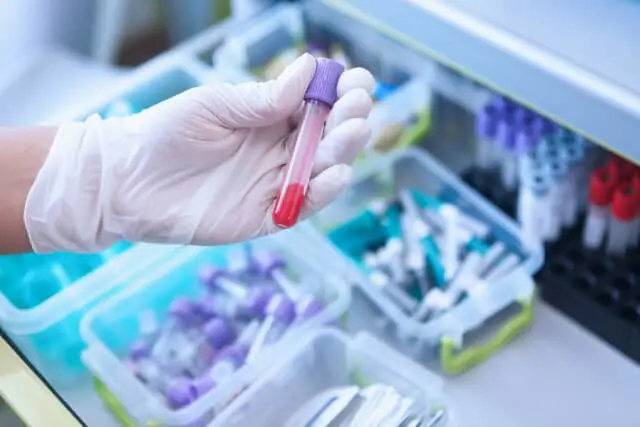Learn about microdeletion syndromes identifiable through early NIPT (Non-Invasive Prenatal Testing) and get concise explanations of each type. Understand the significance of early genetic screening in prenatal care.
Summary of this article
NIPT (Non-Invasive Prenatal Testing) is gaining attention for early detection of microdeletion syndromes. Microdeletion syndromes occur when specific parts of chromosomes are missing or lost, and they are classified into multiple disorders based on the location differences.
This article introduces information about the causes, symptoms, and treatment methods of seven microdeletion syndromes.
- What is Microdeletion Syndrome?
- [Case Study 1.] DiGeorge Syndrome
- [Case Study 2.] 1p36 Deletion Syndrome
- [Case Study 3.] Smith-Magenis Syndrome
- [Case Study 4.] Wolf-Hirschhorn Syndrome
- [Case Study 5.] Prader-Willi Syndrome
- [Case Study 6.] Angelman Syndrome
- [Case Study 7.] 5p Deletion Syndrome
- Four Microdeletion Syndromes Diagnosable at Hiro Clinic NIPT
What is Microdeletion Syndrome?
Microdeletion syndromes are a group of disorders caused by the loss or absence of specific segments of genes on certain chromosomes. These are typically caused by very small deletions, occurring within segments ranging from 500,000 to generally 1-3 million base pairs.
Many severe congenital abnormalities are observed in numerous disorders, which also greatly affect mental development and physical growth. The size and location of the deletion determine the symptoms and severity. Additionally, microdeletion syndromes are considered to occur naturally regardless of maternal age.
Detectable by Early NIPT Testing
NIPT (Non-Invasive Prenatal Testing) is a screening test for prenatal diagnosis, which can be performed non-invasively after the 10th week of pregnancy. This test allows for the detection of microdeletion syndromes.
Furthermore, NIPT testing can also examine chromosomal aneuploidies of autosomes and sex chromosomes, as well as determine the fetal sex, making it possible to detect not only microdeletion syndromes but also common chromosomal disorders, other chromosomal abnormalities, and sex chromosome anomalies. Additionally, it is recommended for those who want to know the baby’s sex as it can also examine the sex chromosomes.

【Case Study1.】DiGeorge Syndrome
DiGeorge syndrome is also referred to as “22q11.2 deletion syndrome” or “thymic hypoplasia syndrome.”
The incidence rate is approximately 1 in 4,000 to 6,000 individuals, but it is currently unknown which individuals are more susceptible to developing it. Congenital conditions are observed in 80% of affected individuals.
Here, we will introduce the causes of onset, detailed symptoms, and treatment methods.
Causes and Symptoms
DiGeorge syndrome is caused by a microdeletion of chromosome 22q11.2, which is the 22nd chromosome. Onset occurs when approximately 30 genes in this region are missing. About 80% of patients exhibit associated complications.
The main symptoms include developmental delay, distinctive facial features, immunodeficiency, cleft palate, velopharyngeal insufficiency, congenital heart disease, thymic hypoplasia, hypocalcemia, and nasal voice. Additionally, there is a risk of language development delay and renal abnormalities in conjunction with intellectual developmental delay.
Treatment
There is no treatment method for the chromosomal abnormality itself. However, there are treatment methods available for the complications it causes.
Priority is given to treating cardiac-related symptoms. From the neonatal period, individualized cardiac surgery plans are developed according to each patient’s condition, and lifelong treatment and lifestyle guidance based on clinical symptoms are necessary.
【Case Study2.】1p36 Deletion Syndrome
1p36 deletion syndrome is a syndrome where a deletion occurs in the 1p36 region of the short arm of chromosome 1. The incidence rate is reported to be approximately 1 in 10,000 individuals overseas, but surveys conducted in Japan predict it to be around 1 in 25,000 to 1 in 40,000 individuals.
Many cases of onset are caused by chromosomal abnormalities arising from spontaneous mutations.
Here, we will introduce the causes of onset, detailed symptoms, and treatment methods.
Causes and Symptoms
It is caused by the congenital loss of the short arm of chromosome 1. There are two main ways this can occur: when the loss of the short arm of chromosome 1 happens suddenly and independently, and when it occurs due to unbalanced translocation caused by one of the parents’ balanced translocations.
The main symptoms include growth retardation, intellectual developmental delay, intractable epilepsy, distinctive facial features, hypotonia, and feeding difficulties. Complications may include congenital heart disease, strabismus, hearing loss, cataracts, obesity, and neuroblastoma.
Intellectual and motor developmental delays are observed in many patients, but the severity varies widely.
Treatment
There is no fundamental treatment for chromosomal abnormalities. Treatment is provided for each symptom.
For example, developmental delays and hypotonia may be alleviated by early intervention with developmental therapy during infancy.
Furthermore, genetic counseling based on genetic diagnosis is essential for the families of patients.
【Case Study3.】Smith-Magenis Syndrome
Smith-Magenis syndrome is a congenital abnormality syndrome caused by a deletion in the 17p11.2 region of the gene. It is estimated that there are 30 to 50 patients in Japan. It is not known who is more susceptible to developing it.
There are hardly any individuals with Smith-Magenis syndrome in the patient’s lineage or family, and it is presumed to occur sporadically.
Here, we will introduce the causes of onset, detailed symptoms, and treatment methods.
Causes and Symptoms
The cause is the deletion of one of the two 17th chromosome short arms in the middle region. It has been revealed that haploinsufficiency of the RAI1 gene within the deletion region is involved in the onset.
While most cases are due to partial deletions of the chromosome region containing RAI1, a small number of cases with RAI1 gene mutations have also been reported.
The main symptoms include intractable epilepsy, peripheral neuropathy, distinctive facial features, intellectual developmental delay, congenital heart disease, self-injurious behavior, and behavioral abnormalities. Some patients also experience sleep disorders due to decreased or absent REM sleep.
Treatment
There is no treatment method to improve the chromosomal abnormality itself. Treatment is provided according to each symptom.
For example, antiepileptic drugs are administered for epilepsy. Continuous rehabilitation and counseling are necessary for self-injurious behavior and behavioral abnormalities.
In the treatment of sleep disorders, as the use of medications is limited in Japan, treatment centered around rehabilitation is necessary.
【Case Study4.】Wolf-Hirschhorn Syndrome
Wolf-Hirschhorn syndrome is also known as “4p deletion syndrome.” It is a syndrome that occurs due to a deletion in the 4p16.3 region of the gene. It is predicted to occur in approximately 1 in 50,000 individuals, with a male-to-female ratio of 1:2.
Due to the various sizes of deletions, there is a possibility that small patients are being overlooked, and it is believed that there may actually be more patients than currently known.
Here, we will introduce the causes of onset, detailed symptoms, and treatment methods.
Causes and Symptoms
The cause is haploinsufficiency due to the deletion of a group of genes located on the short arm of chromosome 4. Most cases are due to single deletions caused by spontaneous mutations, but in rare cases, they may occur as a result of unbalanced reciprocal translocations.
The main symptoms include growth retardation, hypotonia, distinctive facial features, intellectual developmental delay, motor developmental delay, intellectual disability, intractable epilepsy, feeding difficulties, skeletal abnormalities, congenital heart disease, hearing impairment, urinary tract abnormalities, and brain structural abnormalities.
Treatment
There is no treatment method to treat the chromosomal abnormality itself. Treatment tailored to each symptom is necessary.
For example, rehabilitation is conducted to improve motor and cognitive abilities, language skills, and social skills for intellectual and motor developmental delays.
For feeding difficulties, feeding training is conducted, and if gastroesophageal reflux disease is present, surgical treatments such as gastrostomy or fundoplication may be necessary.
【Case Study5.】Prader-Willi Syndrome
Prader-Willi syndrome was the first identified imprinting disorder. The incidence rate is 1 in 10,000 to 15,000 individuals, and it is considered to occur with no racial differences.
Here, we will introduce the causes of onset, detailed symptoms, and treatment methods.
Causes and Symptoms
It is believed to occur due to the loss of the function of multiple genes located on paternally derived chromosome 15 trisomy q11-q13.
The factors causing the loss of function of the paternally expressed genes include paternal chromosome microdeletions at 15q11-q13, maternal uniparental disomy of chromosome 15, and imprinting mutations due to genomic imprinting disorders.
The main symptoms include decreased muscle tone, hypopigmentation, genital abnormalities, obesity, short stature, distinctive personality disorders, abnormal behavior, and diabetes.
Treatment
There is no treatment for the chromosome abnormalities themselves. Treatment tailored to each symptom is required.
Currently, dietary therapy, exercise therapy, growth hormone replacement therapy, hormone replacement therapy, and management of psychiatric disorders are being implemented. Additionally, since there is moderate-level intellectual developmental delay, appropriate support is essential.
【Case Study6.】Angelman Syndrome
Angelman syndrome is a disorder characterized by severe developmental delay, epilepsy, ataxic movements, and frequent laughter at minor stimuli. It is said to occur at a frequency of approximately 1 in 15,000 individuals, with around 500 to 1000 confirmed cases in Japan.
Here, we will introduce the causes of onset, detailed symptoms, and treatment methods.
Causes and Symptoms
The onset occurs when the function of the UBE3A gene, located on the short arm q11-q13 of chromosome 15, is lost. Factors leading to the loss of gene function include maternal microdeletion at 15q11-q13, paternal uniparental disomy of chromosome 15, imprinting abnormalities due to genomic imprinting disorders, and mutations in UBE3A.
The main symptoms include severe mental developmental delay, epilepsy, ataxic movements, inappropriate laughter, sleep disturbances, distinctive facial features, and hypopigmentation.
Treatment
Since it’s not possible to directly address the chromosome abnormality itself, symptomatic treatment tailored to each symptom is administered.
For instance, epilepsy can be managed by taking antiepileptic drugs at appropriate intervals to prevent seizures and enable a functional life. Sleep disturbances are typically addressed through symptomatic therapy, such as the use of sleep aids.
【Case Study7.】5p Deletion Syndrome
5p deletion syndrome is one of the chromosomal abnormality syndromes, affecting approximately 1 in 15,000 to 50,000 individuals. Additionally, the proportion of patients demonstrating developmental delay is approximately 1 in 350 individuals.
Here, we will introduce the causes of onset, detailed symptoms, and treatment methods.
Causes and Symptoms
The primary cause of onset is largely attributed to partial deletion of the short arm of chromosome 5. Additionally, it is occasionally said to occur due to chromosomal mosaicism resulting from unbalanced reciprocal translocations or structural abnormalities involving two lineages, as well as structural abnormalities derived from chromosomal inversions present in either parent.
The main symptoms include low birth weight, growth retardation, delayed motor development, constipation, and decreased muscle tone. Patients may also develop symptoms related to the circulatory, respiratory, digestive, genitourinary, orthopedic, and dental systems, but the types and frequencies of these symptoms vary among individuals.
Treatment
There is no method to treat the fundamental cause, which is the chromosomal abnormality. Treatment is instead directed towards managing the complications.
Since the complications to watch out for vary by age, treatment and management tailored to each complication are necessary. For instance, in the newborn period, treatment focuses on managing growth retardation due to the susceptibility to respiratory symptoms and feeding difficulties.
Four Microdeletion Syndromes Diagnosable at Hiro Clinic NIPT
Microdeletion syndromes can be detected early through Non-Invasive Prenatal Testing (NIPT). At Hiro Clinic, NIPT offers screening for four microdeletion syndromes, including DiGeorge syndrome, 1p36 deletion syndrome, Smith-Magenis syndrome, and Wolf-Hirschhorn syndrome.
By detecting abnormalities early through testing, it becomes possible to understand fetal abnormalities before childbirth and begin preparations for delivery methods and postnatal treatment.
Moreover, early awareness allows for mental preparation. Utilizing early NIPT testing enables appropriate treatment and fosters the healthy growth of your child.
【References】
- MSD Manual Professional Edition: Microdeletion Syndromes and Microduplication Syndromes
- NIPT Testing Center
- Report of the Special Committee on Prenatal Testing such as NIPT
- NIPT Japan: New Type Prenatal Diagnosis (NIPT)
- Rare Disease Information Center 22q11.2 Deletion Syndrome
- Pediatric Chronic Specific Disease Information Center Thymic Hypoplasia (DiGeorge Syndrome)
- Ministry of Health, Labour and Welfare 1p36 Deletion Syndrome
- Rare Disease Information Center 1p36 Deletion Syndrome
- Ministry of Health, Labour and Welfare Smith-Magenis Syndrome
- Rare Disease Information Center Smith-Magenis Syndrome
- Pediatric Chronic Specific Disease Information Center Smith-Magenis Syndrome
- Ministry of Health, Labour and Welfare 4p Deletion Syndrome
- Rare Disease Information Center 4p Deletion Syndrome
- Ministry of Health, Labour and Welfare Prader-Willi Syndrome
- Rare Disease Information Center Prader-Willi Syndrome
- Ministry of Health, Labour and Welfare Angelman Syndrome
- Rare Disease Information Center Angelman Syndrome
- Rare Disease Information Center 5p Deletion Syndrome
- Ministry of Health, Labour and Welfare 5p Deletion Syndrome
Q&A
-
QUntil what week of pregnancy can early NIPT (Non-Invasive Prenatal Testing) be conducted?There isn't a strict restriction on when it must be done. However, it's advisable to undergo the test early, considering procedures like amniocentesis. At Hiro Clinic NIPT, you can undergo the test shortly after confirming fetal heartbeat via ultrasound examination.
-
QWhat is the accuracy of early NIPT (Non-Invasive Prenatal Testing)?Early NIPT testing is a screening test (non-definitive). While not definitive, Hiro Clinic NIPT conducts highly accurate testing.
Learn about microdeletion syndromes identifiable through early NIPT (Non-Invasive Prenatal Testing) and get concise explanations of each type. Understand the significance of early genetic screening in prenatal care.
Article Editorial Supervisor

岡 博史先生
【役職】
【資格】
【略歴】
【所属】
【SNS】
 中文
中文













